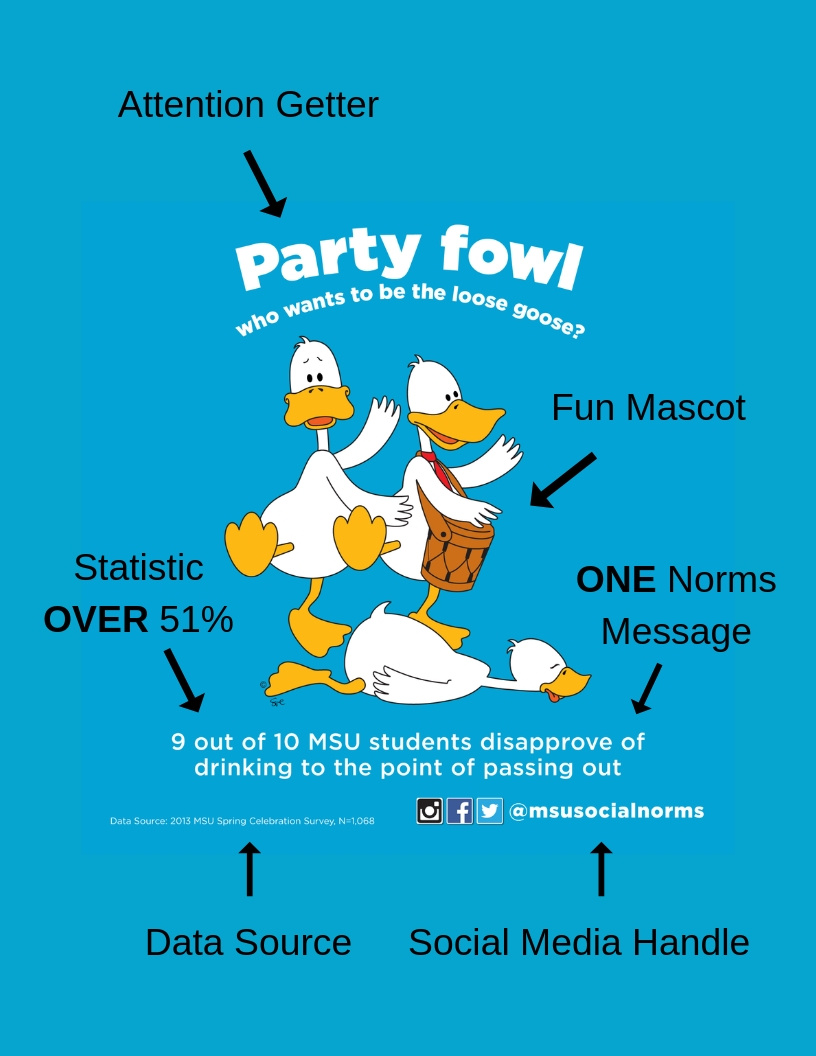Creating a high quality social norms message can be a more complex process than it seems. Luckily, the National Social Norms Center is here to walk you through everything you need to know! This guide provides a checklist of 9 essential features of a good social norms message. You should use this as a reference before you begin designing your campaign to help you in the planning stages, during the designing to keep you on track, and once you’ve finished your materials as a check-list to make sure you have everything you need:
1. Use Social Norms
In order for your social norms campaign to be effective and create the change you wish to see, it’s critical to make sure that the message you’re writing actually includes a social norm. There are 2 types of social norms:
- Descriptive Norms: The behaviors engaged in by a majority of the members of an identified group or population.
- Injunctive Norms: The beliefs held by a majority of the members of an identified group or population.
2. Use a Majority Message
The consistent piece in the definitions of the two categories of social norms is that they concern the majority of a group or population. This means that when you’re analyzing your data to include your message, you should be using items that support your end goal and that over 50% of respondents chose the same option for. However, this doesn’t mean that you should completely avoid looking at items that scored low. You can still turn these into a majority message by flipping the verbiage and calculating the difference! For example, if 10% of students reported that they don’t stay with a group of friends when they partied (not a majority message), this could mean that 90% of students do stay with friends when they party (which is a majority message)! Some additional examples are listed below to help you out. If you’re creating a message targeted towards students at X University:
- NOT Social Norms: “30% of X University students approve of drinking to the point of passing out”
- Social Norms: “70% of X University students disapprove of drinking to the point of passing out”
3. Make the Social Norms Message Prominent and Focal
You can have the perfect social norms messages and still wind up with ineffective campaign materials if your messages are not the prominent and focal aspect of your designs. It is easy to get so caught up in creating flashy and attractive designs, that you forget that the whole purpose is to get your social norms message out to your target audience. While you certainly want to catch the attention of your audience using visual features, you want these features to supplement your social norms message rather than the other way around.
4. Make the Message Clean and Simple
In addition to your social norms messages being the prominent and focal part of your design, they should also be clean and simple to read. If your audience has to work hard to understand the main point of your message whether it’s because of the verbiage of the statement, or conflicting design aspects, the message may not be received the way you want it to.
5. Use UCelebrate Data Correctly
Ensuring you’re using your data correctly is a key step to producing the results you’d like to see, and being able to properly evaluate your campaign later. In order to correctly use survey data to produce a social norms message, your message should use whole numbers. For example:
- DO Use:
- “80%”
- “8/10”
- Do NOT Use:
-
- “79.7%” → You’d want to round this number to “80%”
When using survey data to produce a social norms message, you should also follow the exact verbiage included in the survey you pulled the data from. For example, if you used a survey item that stated “Do you approve of getting medical help for a friend who has drunk too much alcohol?”, your social norms message might look like this: ” 94% of MSU students approve of getting medical help for a friend who has drunk too much alcohol.”
6. Cite a Credible Source
Using a credible source can make or break whether your target audience is accepting of your social norms message. You need to ensure that your source is relevant to the information you’re including in your message and used proper research protocol. Additionally, you need to know how to cite your source correctly within your campaign materials.
1. Avoid Using Prescriptive Messages
It’s important that when designing your campaign, you avoid telling people what to do. Using phrases such as “do” and “do not” undermine the power of a social norms message. Survey data most likely won’t use those words, so if you’re using the data correctly by following the exact survey verbiage this means that these words should not appear in your message. If they do, you should double check all of your information and ensure you’re using the correct terminology in your message.
2. Avoid Including Multiple Messages
Have you included more than one social norms data point? Displaying a graphic that includes several social norms messages/data points can weaken its effectiveness and make the evaluation of that message in the UCelebrate survey more difficult. Additionally, if your messages are rotated frequently, this could hurt the effectiveness and recall of the message in the long run. For the best results, you should stick to a single social norms message per design.
3. Eliminate Competing Information
Social norms messaging should be cohesive and synergistic. Always pair a social norms message with related and appropriate information on posters/graphics. For example, if the social norms message talks about students drinking 0-3 drinks but is coupled with information on medical amnesty, it may undermine the social norms message.
For a PDF version of this guide, click here: Social Norms Message Creation Guide






